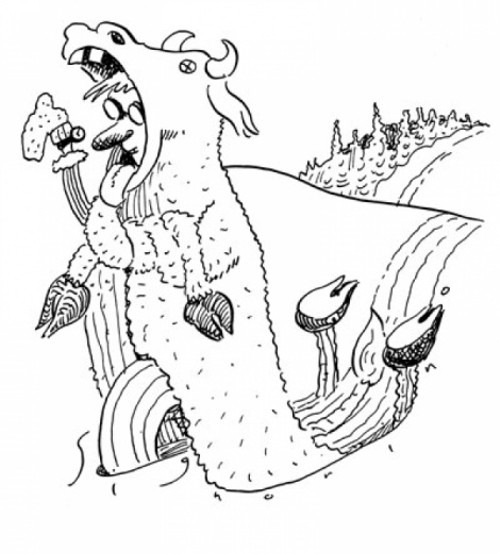In The Empire Strikes Back, there’s a scene where Han Solo must cut open his tauntaun and climb inside the steaming corpse with Luke. They do this to avoid what appear to be Arctic conditions on the ice planet Hoth. My questions: If I were to find myself in similar conditions on Earth, what would be the best animal of similar size (300 to 600 kilos) to slice up and crawl inside, and how long could I seek refuge in the corpse? —TD
No doubt about it, the home mortgage crisis has entered an alarming new phase. However, taking shelter inside dead animals can’t really be considered an affordable housing option. For one thing, in the movie, Han doesn’t crawl into the tauntaun himself; he merely stuffs the freezing Luke into it while he sets up conventional shelter, probably using an FHA-backed loan. What’s more, he does this only because the tauntaun has just conveniently died. Had the mephitic beast still been ambulatory, a better plan would have been to ride it back to the hotel. My point is, don’t start eyeing local mammals unless you’ve ruled out doubling up with the in-laws first.
Let’s suppose, though, that you’re caught seriously short. For example, you’re the disgraced CEO of a bankrupt hedge fund that can’t account for hundreds of millions of dollars of its customers’ money. Naturally, your innate sense of justice and honor obliges you to sell all your personal assets to pay everybody back. But it’s too nippy to live in a barrel, and they won’t let you run a tab at the Motel 6.
What animal do you choose? Many large warm-blooded critters would do, such as a bear, water buffalo, or rhinoceros. Historically, however, the emergency refuge of choice was a horse. Here we have a problem. Where these days can you find a horse? The U.S. has more horses than you might think—by one estimate, more than nine million. However, it’s fair to say they’re virtually all horses somebody wants. Slice one open even in case of dire necessity and you’re likely to hear from one PO’d little girl or dressage buff. Cows are less of an issue, but you still take the chance of having PETA come over and picket your house.
A possible alternative is to head up to Alaska, where not only is the political if not the actual climate more favorable, there are hundreds of thousands of free-range caribou, as we’ve recently learned. The drawback is that the caribou, like most deer, is much smaller than a horse, maxing out at about 200 kilograms, so you’re likely to have to settle for warming up selected extremities rather than your entire person. From the standpoint of adequate accommodation and availability, you’d better resign yourself to a cow.
Now for the practicalities. The TV program Man vs. Wild featured an episode where its host skinned, disemboweled and crawled inside an Arabian camel, claiming Berber tribesmen did so as emergency shelter from sandstorms. A likely story; nonetheless, he was in fact able to get most of himself in there. Just recently, a creepette from Portland, Ore., signed up for her 15 minutes of fame by stripping naked and climbing inside the bloody carcass of a horse while her boyfriend took gruesome glamour shots. So we know it can be done.
That said, I could find only one case where someone had actually climbed into an animal to survive the cold as opposed to trying to get on TV, namely an intrepid pioneer priest named Father Goiffon. Assigned to minister to the hamlet of Pembina, N.D., Goiffon was summoned in August 1860, to Saint Paul, Minn., for a church meeting. He went, but rightly feared he wouldn’t make it back home before winter. Goiffon began the return trip in bad weather in late October and, after camping with fellow travelers on Nov. 1, ventured alone into the wilderness. The rain turned to snow, and he got lost. When his horse finally died, the enterprising priest cut open its belly and crawled inside the carcass. He was mostly successful—his equine sleeping bag saved his life, but he lost his leg due to frostbite.
How much time would sheltering in a deceased animal buy you? Assuming a bitterly cold day (9 degrees Fahrenheit), a stiff wind (12 miles per hour) and a 500-kilogram cow with half its insides scooped out, and factoring in the heat produced by the resident human, my assistant Una estimates the cow’s body would lose about 3 degrees per hour. She concludes you’d have right around 15 hours, best case, before hypothermia set in.
What then? Ideally, you want a long-term solution such as a nice condo. However, given the national predilection for kicking the can down the road, probably all you can hope for are enough cows to last you till spring.
Send questions to Cecil via StraightDope.com or write him c/o Chicago Reader, 11 E. Illinois, Chicago 60611. Subscribe to the Straight Dope podcast at the iTunes Store.
More by Cecil Adams
-
This Is the End, My Friend
This week's Straight Dope marks the last appearance of the column as the Teeming Millions have known it for the past 45 years.
- Jul 11, 2018
-
Do Brain Supplements Do Anything?
Brain Drain
- Jul 4, 2018
-
Is flying really worse for the environment than driving?
Planes and Trains
- Jun 27, 2018
- More »




